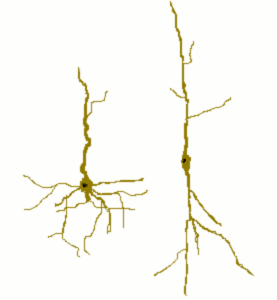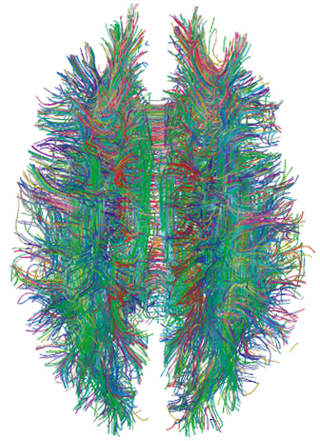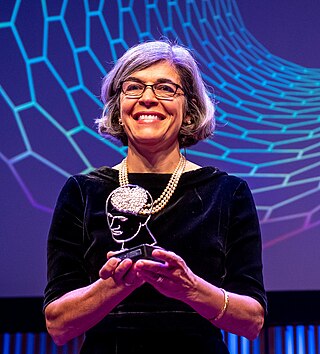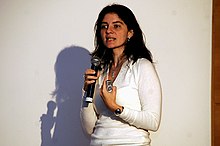
The cerebral cortex, also known as the cerebral mantle, is the outer layer of neural tissue of the cerebrum of the brain in humans and other mammals. It is the largest site of neural integration in the central nervous system, and plays a key role in attention, perception, awareness, thought, memory, language, and consciousness. The cerebral cortex is the part of the brain responsible for cognition.

The neocortex, also called the neopallium, isocortex, or the six-layered cortex, is a set of layers of the mammalian cerebral cortex involved in higher-order brain functions such as sensory perception, cognition, generation of motor commands, spatial reasoning and language. The neocortex is further subdivided into the true isocortex and the proisocortex.

A cortical minicolumn (also called cortical microcolumn) is a vertical column through the cortical layers of the brain. Neurons within the microcolumn "receive common inputs, have common outputs, are interconnected, and may well constitute a fundamental computational unit of the cerebral cortex". Minicolumns comprise perhaps 80–120 neurons, except in the primate primary visual cortex (V1), where there are typically more than twice the number. There are about 2×108 minicolumns in humans. From calculations, the diameter of a minicolumn is about 28–40 μm. Minicolumns grow from progenitor cells within the embryo and contain neurons within multiple layers (2–6) of the cortex.

A cortical column is a group of neurons forming a cylindrical structure through the cerebral cortex of the brain perpendicular to the cortical surface. The structure was first identified by Mountcastle in 1957. He later identified minicolumns as the basic units of the neocortex which were arranged into columns. Each contains the same types of neurons, connectivity, and firing properties. Columns are also called hypercolumn, macrocolumn, functional column or sometimes cortical module. Neurons within a minicolumn (microcolumn) encode similar features, whereas a hypercolumn "denotes a unit containing a full set of values for any given set of receptive field parameters". A cortical module is defined as either synonymous with a hypercolumn (Mountcastle) or as a tissue block of multiple overlapping hypercolumns.

Renato Marcos Endrizzi Sabbatini is a retired professor at the Department of Biomedical Engineering and at the State University of Campinas Institute of Biology. He received a B.Sc. in Biomedical Sciences from Medical School of the University of São Paulo and a doctorate in behavioral neuroscience in 1977, followed by postdoctoral work at the Max Planck Institute of Psychiatry's Primate Behavior Department. He founded the Center for Biomedical Informatics, and helped create the Brazilian Society for Health Informatics.

Brain–body mass ratio, also known as the brain–body weight ratio, is the ratio of brain mass to body mass, which is hypothesized to be a rough estimate of the intelligence of an animal, although fairly inaccurate in many cases. A more complex measurement, encephalization quotient, takes into account allometric effects of widely divergent body sizes across several taxa. The raw brain-to-body mass ratio is however simpler to come by, and is still a useful tool for comparing encephalization within species or between fairly closely related species.

Von Economo neurons, also called spindle neurons, are a specific class of mammalian cortical neurons characterized by a large spindle-shaped soma gradually tapering into a single apical axon in one direction, with only a single dendrite facing opposite. Other cortical neurons tend to have many dendrites, and the bipolar-shaped morphology of von Economo neurons is unique here.
Encephalization quotient (EQ), encephalization level (EL), or just encephalization is a relative brain size measure that is defined as the ratio between observed and predicted brain mass for an animal of a given size, based on nonlinear regression on a range of reference species. It has been used as a proxy for intelligence and thus as a possible way of comparing the intelligence levels of different species. For this purpose, it is a more refined measurement than the raw brain-to-body mass ratio, as it takes into account allometric effects. Expressed as a formula, the relationship has been developed for mammals and may not yield relevant results when applied outside this group.

Miguel Ângelo Laporta Nicolelis, is a Brazilian scientist, physician and Duke School of Medicine Professor in Neuroscience at Duke University, best known for his pioneering work surrounding brain-computer interface technology.

Aristides Azevedo Pacheco Leão was a Brazilian neurophysiologist, researcher and university professor.
The Prêmio José Reis de Divulgação Científica is an annual honor awarded by the Brazilian Council of Scientific and Technological Development (CNPq) to the institution, media organization, publication, or individual who most contributed to the dissemination and public awareness of science and technology in Brazil. It is thus named in honor of Dr. José Reis, a Brazilian biologist and science writer who was one of the pioneers in the field.

Pasko Rakic is a Yugoslav-born American neuroscientist, who presently works in the Yale School of Medicine Department of Neuroscience in New Haven, Connecticut. His main research interest is in the development and evolution of the human brain. He was the founder and served as Chairman of the Department of Neurobiology at Yale, and was founder and Director of the Kavli Institute for Neuroscience. He is best known for elucidating the mechanisms involved in development and evolution of the cerebral cortex. In 2008, Rakic shared the inaugural Kavli Prize in Neuroscience. He is currently the Dorys McConell Duberg Professor of Neuroscience, leads an active research laboratory, and serves on Advisory Boards and Scientific Councils of a number of Institutions and Research Foundations.

A connectome is a comprehensive map of neural connections in the brain, and may be thought of as its "wiring diagram". An organism's nervous system is made up of neurons which communicate through synapses. A connectome is constructed by tracing the neuron in a nervous system and mapping where neurons are connected through synapses.

There is much to be discovered about the evolution of the brain and the principles that govern it. While much has been discovered, not everything currently known is well understood. The evolution of the brain has appeared to exhibit diverging adaptations within taxonomic classes such as Mammalia and more vastly diverse adaptations across other taxonomic classes. Brain to body size scales allometrically. This means as body size changes, so do other physiological, anatomical, and biochemical constructs connecting the brain to the body. Small bodied mammals have relatively large brains compared to their bodies whereas large mammals have smaller brain to body ratios. If brain weight is plotted against body weight for primates, the regression line of the sample points can indicate the brain power of a primate species. Lemurs for example fall below this line which means that for a primate of equivalent size, a larger brain would be expected. Humans lie well above the line indicating that humans are more encephalized than lemurs. In fact, humans are more encephalized compared to all other primates. This means that human brains have exhibited a larger evolutionary increase in complexity relative to size. Some of these evolutionary changes have been found to be linked to multiple genetic factors, such as proteins and other organelles.

Anna Christina Nobre FBA, MAE, fNASc is a Brazilian and British cognitive neuroscientist working at Yale University in New Haven, CT, USA.
Gyrification is the process of forming the characteristic folds of the cerebral cortex.
In the field of computational neuroscience, Brain simulation is the concept of creating a functioning computer model of a brain or part of a brain. Brain simulation projects intend to contribute to a complete understanding of the brain, and eventually also assist the process of treating and diagnosing brain diseases. Simulations utilize mathematical models of biological neurons, such as the hodgkin-huxley model, to simulate the behavior of neurons, or other cells within the brain.
Fronteiras do Pensamento(Portuguese: Frontiers of Thought) is a Brazilian cultural project that promotes conferences featuring internationally known intellectuals in order to discuss issues of contemporaneity. Scientific discovery, social research, sustainable solutions, philosophical theses, influences on the ways of understanding and interpreting the world, social/political leadership and activism, are a few of the issues discussed during Frontiers of Thought's annual conference seasons. The project's online content is freely available worldwide, and offers hundreds of videos, subtitled in Portuguese, Spanish and English, as well as articles, news and interviews.

The mouse brain refers to the brain of Mus musculus. Various brain atlases exist.














